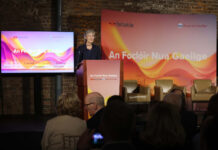By Donal O’Keeffe
Carmel Cantwell posted a beautiful photo last week. Wild barley and clover decorate the foreground, and in the middle of an overgrown meadow a tiny figure in white walks away in the distance. Above her, tower Scots Pine trees beneath a pale and cloudy sky.
“My mother at Carr’s Hill Cemetery for the first time after hearing her son was buried here over 58 years ago,” Carmel wrote. “A lonely figure looking for any evidence of burials on a huge site. It is… believed that 113 children (who) died in St Finbarr’s hospital (and) were born in Bessborough are buried here.”
Originally a Famine graveyard, All Saints Cemetery on Carr’s Hill is a five-and-half-acre site, up on the left as you drive from Douglas to Carrigaline. It’s estimated that 30,000 people were buried there in Famine times, 2,260 people from Cork City Workhouse in Black ’47 alone. A display outside the abandoned cemetery says it also served as the site of paupers’ graves for Cork’s poor and unclaimed dead ‘until the 1950s’. It seems now that date may be incorrect by at least a decade.
Carmel Cantwell’s mother Bridget, believed until very recently that her baby boy William was buried in the corner of the nuns’ graveyard in Bessborough which became known very recently as ‘the angels’ plot’. I’ve written here before about Bridget.
Bridget was 17 in 1960, when she became pregnant. She went to London, where a visit to confession put her in the clutches of a Catholic group called ‘The Crusade of Rescue’. They shipped Bridget back to Ireland, to the mother and baby home run by the Sisters of the Sacred Hearts of Jesus and Mary in Bessborough in Cork.
Completely alone, Bridget was stripped of her possessions, and her name. Her family had no idea she was in Bessborough, and she was forced to write letters home pretending she was in London. Those letters – along with letters from the other Bessborough inmates – were posted to The Crusade of Rescue in London and then sent back to Ireland, with an English postmark to complete the ‘respectable’ illusion.
While Bridget was in labour, the nuns gave her an injection. When Bridget’s baby William – who initially thrived – was three days old, he became suddenly poorly. Bridget also became very ill, and William was taken from her. Terrified, Bridget begged the nuns to bring her baby to a doctor or to take him to hospital. They refused.
Bridget developed a huge abscess from the injection, and she overheard the nuns squabbling, with one accusing the other of not sterilising the needle. When he was 19 days old, William was taken, too late, to St Finbarr’s Hospital. He lived for another 19 days.
William was six weeks old when he died. Bridget was informed by the nuns of his death and told he had already been buried.
That was a vicious, evil lie.
William would not be buried until after Bridget had left Bessborough, and then, it seems, because he was ‘unclaimed’, he was buried in Carr’s Hill.
Bridget was sent back to the UK, still very ill, and completely distraught at the loss of her beloved baby William. She tried, three times, to take her own life and was placed into psychiatric care where, in time, she would try to put her life back together, even as she struggled all the while with unimaginable grief.
The years passed, and in 1994 Bridget telephoned the Sisters of the Sacred Hearts of Jesus and Mary at Bessborough, asking – as her daughter Carmel Cantwell puts it – “what her son died from, how old he was when he died, was a priest present at his burial, where was he buried and why was she not told about or allowed to attend her own son’s funeral?”
The Sisters of the Sacred Hearts of Jesus and Mary made an inquiry to the chaplaincy at St Finbarr’s Hospital. A letter was returned to them advising that William had been buried – ‘unclaimed’ – at Carr’s Hill. The nuns chose not to tell Bridget.
A few months later, Bridget went to Cork, and, she told me, she ‘plucked up enough courage to confront the nuns at Bessborough’.
Carmel says she was taken to the nuns’ graveyard but told to stand outside it. “Then a nun tapped her foot on the ground in the graveyard and said that William was buried right there.”
We know now that was another lie. Some might say the lie was motivated by kindness, but that too came wrapped in cruelty.
“Even then my mother was refused entry into the graveyard so that she could pay her respects to her son at his alleged resting place,” Carmel says. “Her request to place a marker there for her baby was declined.”
A few years later, emboldened in the wake of the Tuam Babies story, Bridget and Carmel placed a marker on the spot anyway.
“Beautiful Angel William Gerald Walsh 26-10-1960 – 02-12-1960 My heart burns with my love for you and my soul cries out in sorrow having lost you – Mam xxx”
For Bridget, the idea that William was at rest in what she thought was the angels’ plot in Bessborough gave her a little peace.
In April of this year, the fifth interim report of the Commission of Investigation into Mother and Baby Homes landed like a bombshell. It showed that thousands of children died in Irish mother and baby homes, and very few of them received proper burials.
When Alison O’Reilly broke the Tuam Babies story in 2014, the world recoiled in horror at the thought that 796 babies might be buried in a disused Victorian sewerage system. Now we know that what happened in Tuam was not some horrific aberration, a shocking, one-off evil, but rather it was the banal everyday in Holy Catholic Ireland.
In Bessborough alone, over 800 children are missing. More than 900 babies died there, and the Commission of Investigation into Mother and Baby Homes was only able to find graves for 64 of them.
To quote the interim report of the Commission of Investigation into Mother and Baby Homes: “The Congregation of the Sacred Hearts of Jesus and Mary told the commission that they did not know where the children who died in Bessborough are buried. The Commission finds this difficult to comprehend as the Congregation was still providing services to mothers and children right up to the end of the period covered by this investigation” (1922 to 1998).
The Commission describes information provided by the congregation in an affidavit as “speculative, inaccurate and misleading”.
Carmel Cantwell found the report particularly hard reading.
“I saw a paragraph where the set of circumstances were very familiar to me. Even though the details were anonymised, I knew the story to be my mother’s and that of her baby, my brother William”.
The Commission of Investigation told Carmel it was legally unable to pass on documentation relating to William’s burial, and suggested she correspond with Tusla.
“It took another six weeks for them to locate the letter, but eventually, 25 years after it was written, it was passed on to my mother.
“There is a member of the Congregation here at Bessborough who is still alive and has been here for over 50 years, and part of the Congregation for 70 years,” Carmel says. “When I met her just over a year ago, she was well and mobile. It is well documented that she was actually present when some of children died and she registered their deaths.
“Yet in the report from the Commission of Investigation she states that she can’t remember any children dying. The report from the Commission clearly states ‘31 children died in Bessborough during her time there so it is rather surprising that she does not remember any deaths’.”

…
I took a spin up to Carr’s Hill the other night, and I found the going heavy. Once you go through the first set of rusty black gates, you make your way up a short laneway, between oxeye daisies poking through the stone wall on your left, and the overgrown garden of a bungalow on your right.
Your first challenge will be to get over a barred gate, rusted, broken, and held together by wire. After that, you’re on uneven, overgrown ground on the edge of a field, boxed in by a live electric fence. This is the type of terrain where a twisted ankle feels almost inevitable. (If you’re a few years older than me, that could be a broken ankle, or a broken hip, and all the hospital horrors that follow.) Behind you, the traffic roars by on the Carrigaline road. Miles away to the right, a wind turbine turns slowly, far off in Ringaskiddy.
As you approach the rusted grates of All Saints, you can see the ugly, 54-foot-high metal cross which – apart from the neglected commemorative stone unveiled here in 1997 by then-US ambassador Jean Kennedy-Smith – is the only indication that this sprawling, overgrown meadow is the final resting place of 30,000 Famine dead, untold ‘paupers’ and – perhaps – the Bessborough Babies, including Bridget’s beloved William.
“Tell the truth and shame the Devil” is a saying which predates the Congregation of the Sacred Hearts of Jesus and Mary (founded 1800) by at least two centuries. The Bessborough nuns claim to represent Jesus Christ of Nazareth, and His Holy Mother, Mary. Would it be too much for them to tell the truth?
Where are the Bessborough Babies?








